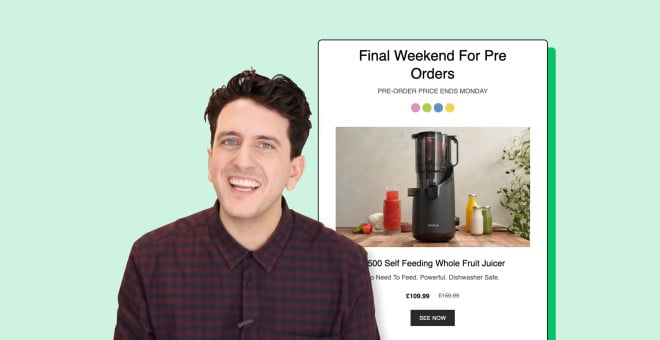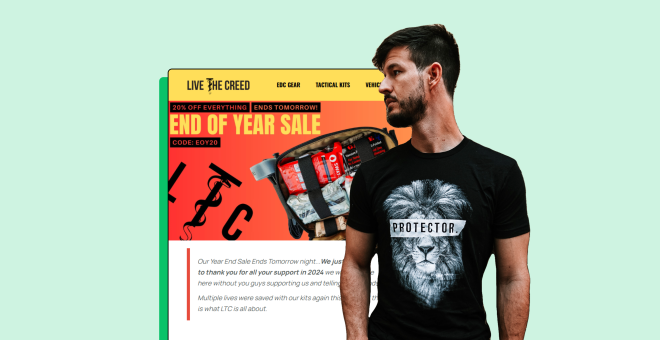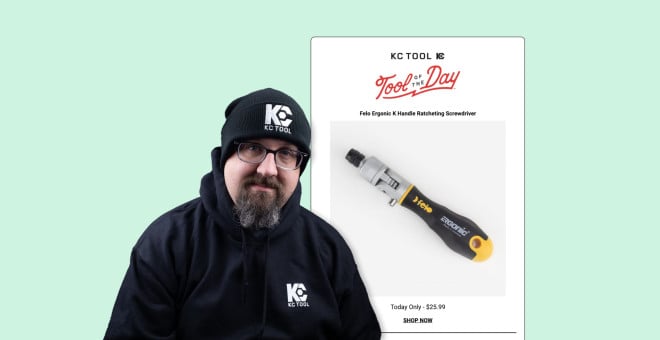Post-purchase email examples and tips to boost loyalty and sales
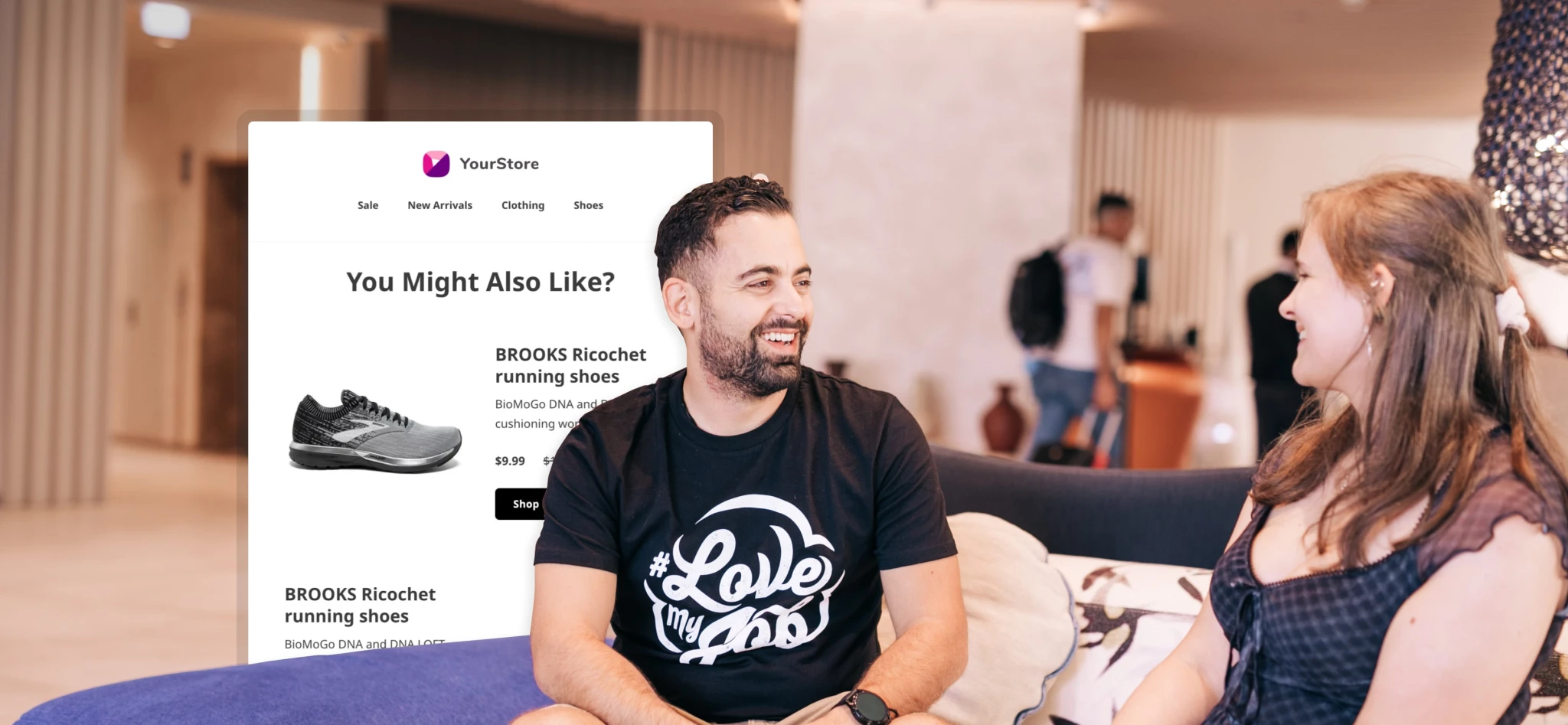 Christos and Aleksandra, customer support
Christos and Aleksandra, customer support
Post-purchase emails are a powerful tool for converting one-time buyers into loyal, repeat customers.
When someone buys from your store, they're not just crossing the finish line of their buyer's journey; they're stepping into a whole new adventure as your customer!
Start the new relationship the right way with a post-purchase email sequence that'll make your customers feel like VIPs. Nail it, and you're on your way to forging unbreakable loyalty, increased trust, and locking in those repeat sales.
In this guide, we’re spilling the secrets of the various types of post-purchase emails, when to send them, and the must-have elements that will make your messages irresistible. Let’s go!
What are post-purchase emails?
Post-purchase emails are automated messages sent to people who buy from your brand. They are a powerful tool for customer relationship management, and they serve multiple key purposes:
Confirming the purchase and providing peace of mind
Providing shipping information and updates
Promoting related products to increase repeat sales
Sharing essential product information to improve the customer experience
While some of these emails, like shipping confirmations, are essential to the buying experience, others are optional but play a big role in creating a memorable brand experience.
Why send post-purchase emails?
Post-purchase emails are essential as they help with:
Increased loyalty: Builds stronger customer relationships
Long-term sales: Drives repeat purchases and referrals
Increased customer lifetime value: Builds trust and satisfaction after the sale
Studying over 22,000 of our e-commerce customers, we found out that post-purchase emails when someone buys a specific product get the highest engagement among all emails, specifically because these emails are so targeted. In fact, these emails have a 76.58% open rate and a 28.43% click rate.
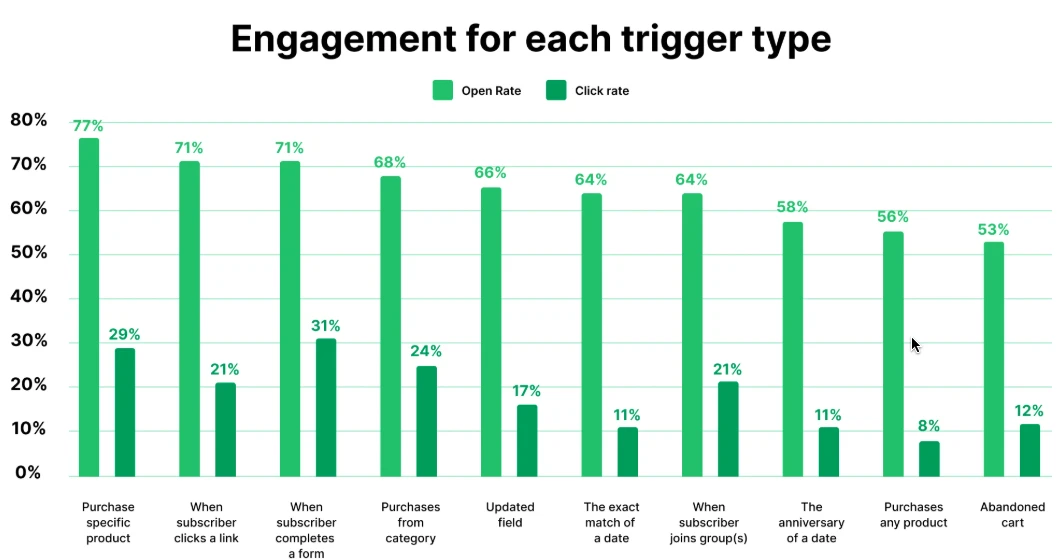
When planning your post-purchase email campaigns, forget about sales for a moment and focus on optimizing the experience someone has when they buy from your brand.
Here’s how Ben Fridja, the founder of the e-commerce store Fridja, thinks about the goal of his brand’s post-purchase sequence.
We don’t just want the customer’s money...We want them to love the product and tell their friends and maybe come back and purchase something else.
The idea is that while you may not be focused on sales initially, a good post-purchase sequence will result in sales further down the line by building a stronger relationship with the customer.
Key benefits of post-purchase emails
Post-purchase emails are a critical tool for any e-commerce business, helping to build trust, increase loyalty, and drive long-term sales.
Here’s a more in-depth look at some of the benefits of a post-purchase sequence:
1. Build trust by meeting customer expectations
Customers expect you to be in touch after a purchase. Sales confirmation and shipping emails are essential for this, not only for building trust but also for proactively reducing support tickets by providing the information customers need.
2. Increase loyalty with better customer experiences
Going beyond the bare minimum is key to creating repeat customers. Post-sales emails allow for continuous communication, transforming a single transaction into a memorable experience that strengthens the customer relationship.
3. Make more sales in the long run
When done right, post-purchase emails can still impact the bottom line by increasing customer retention, leading to more sales via repeat purchases and referrals. McKinsey shows that cross-selling can lead to a 20% increase in sales and 30% increase in profits, respectively.
You can also use your post-purchase emails to promote and cross-sell your products. Be sure to do this in a way that’s respectful of the fact that the customer has just bought from you.
Consider cross-selling products that will improve the customer’s experience with the item they just bought, rather than promoting brand-new products.
Below, you'll learn how to create impactful post-purchase emails. We go through best practices, practical tips, and 9 types of post-sale email to consider using.
9 types of post-purchase emails to use in your sequence
Post-purchase emails can contain anything that you think will improve the experience someone has when they buy a product with your e-commerce brand.
We’ve listed 9 common kinds of post-purchase emails in the section below. Use the ideas as inspiration to build a post-purchase experience your customers love.
Order and shipping confirmations are transactional emails. Most e-commerce platforms like Shopify and WooCommerce have these built-in, just follow the relevant instructions to turn them on. You can also use a transactional messaging tool like MailerSend to build custom transactional experiences.
When creating transactional messages, make sure that any marketing messaging is minimal and that the main content of the email is related to the customer's order.
All the other post-purchase emails in this list are marketing emails. You can use MailerLite to send these messages to people who buy from your store.
Read more about the differences between transactional and marketing emails here.
1. Order confirmation email
Order confirmation emails immediately confirm a successful purchase, giving customers peace of mind.
Send these emails as soon as the customer purchases so they aren’t left wondering if the transaction went through.
These emails typically include:
Order details
Price
Order number
Delivery address
Links to FAQs or support
The exact information you send depends on your product. Digital product sellers may include a link to the product download, while online course providers may share guides to getting started.
If you use our digital product selling feature to sell your products we send an order confirmation that you can customize.
This confirmation email from Coursera is a good example of the latter. It starts with the order details, before moving into tips the course taker can use to optimize their learning.
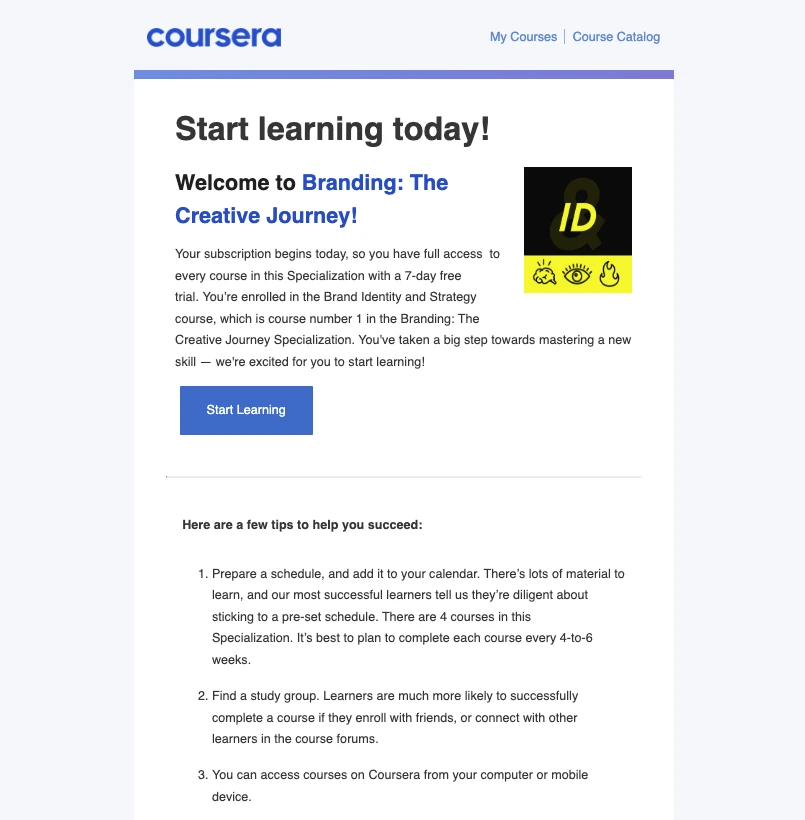
2. Shipping confirmation
Shipping confirmation emails let the buyer know their order has shipped and is on its way.
These emails typically include:
A summary of the order
The shipping tracking number
A link to the shipping company’s tracking page
An estimated delivery date
Links to the customer’s account
At this point, the customer is excited about your product arriving. Capitalize on this feeling by adding content to deepen the customer relationship, such as recommended products or links to your social media profiles.
The below post-purchase email example from Burga contains all the essential elements of a great shipping email, including the ordered products, a tracking link, address confirmation, and estimated delivery.
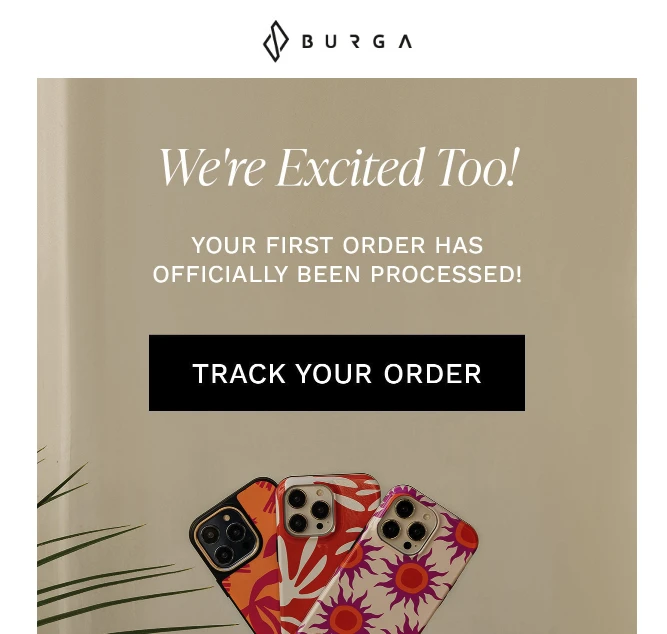
3. Follow-up emails
Follow-up emails contain additional information to help customers get the most out of their purchase.
If you have a small number of products, create post-purchase follow-up emails for each one. If you have many product lines, create more general follow-up emails with information that can be useful for a large number of items.
Send a follow-up email after your order confirmation and shipping emails or create a sequence that delivers these emails over a few days or weeks. The aim is to ensure the customer has all they need for a great start to life with your product.
Once again, the exact information you send will depend on your product. Here are some types of content that may be useful for different businesses:
Course provider: Lesson rundown, community invites, learning tips
Software tool: Set up guides, tips relevant to the buyer’s use case
Fashion store: Styling ideas, product care information
The below email from Peloton is a great example of a follow-up email that is tailored to the product. It asks people who have recently bought a bike to take a quiz to get instructor recommendations.
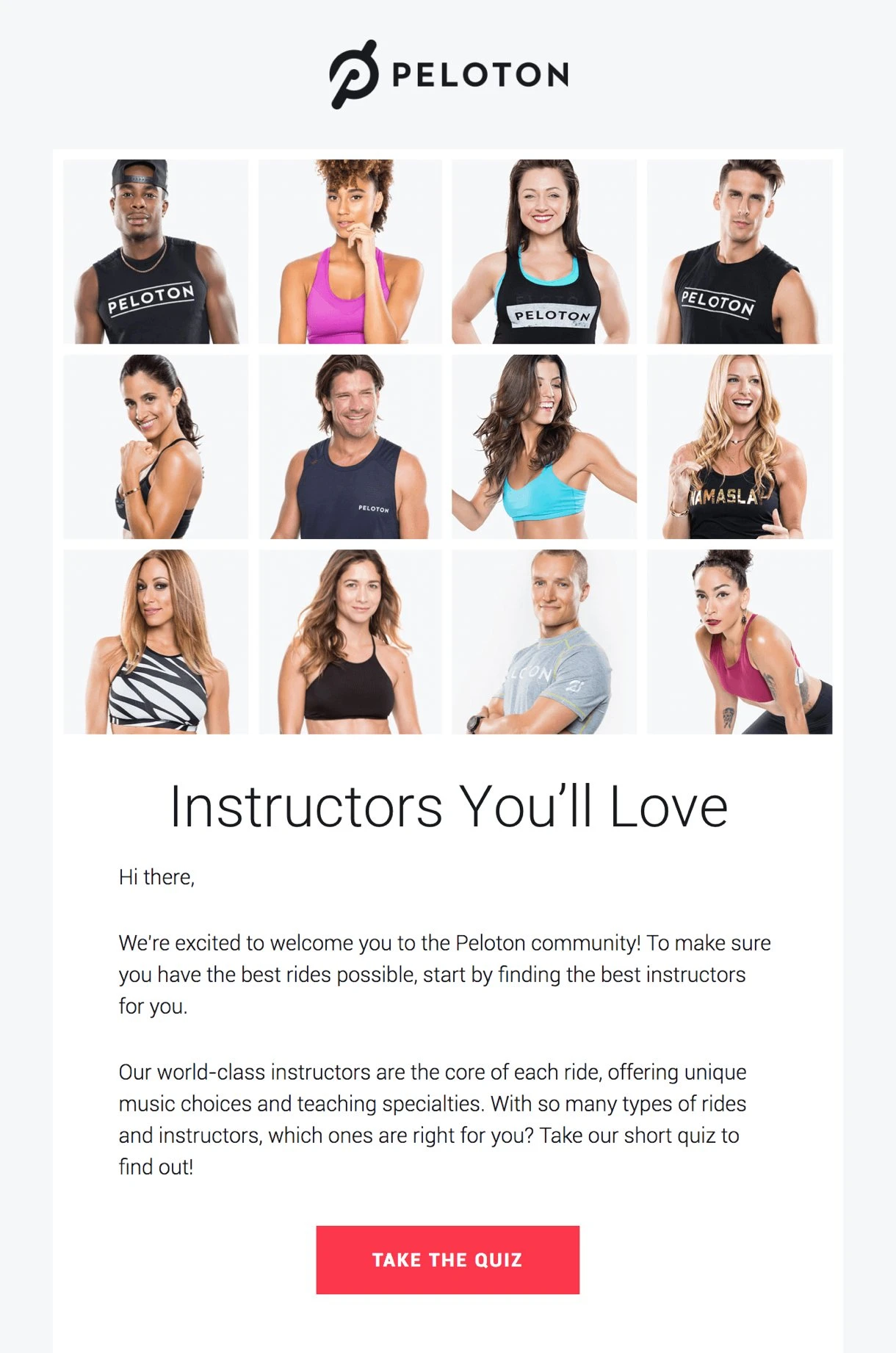
4. Survey emails
Survey emails contain a survey you can use to collect valuable customer feedback and learn more about their experience with your product.
Send these feedback request emails when the customer has had a chance to try out your product, but don’t leave it so long that they are no longer excited about the purchase.
These emails typically contain:
A thank you note
Order details
A short description of what the survey is for
How long the survey will take
A link to the survey
How you add the survey depends on the platform you use. With MailerLite you can embed a survey in your email for easy access, or add a link to a survey on a third-party platform.
This email from Marks & Spencer ticks all the boxes above. It’s clear what the survey is about, how long it will take, and which purchase it relates to.
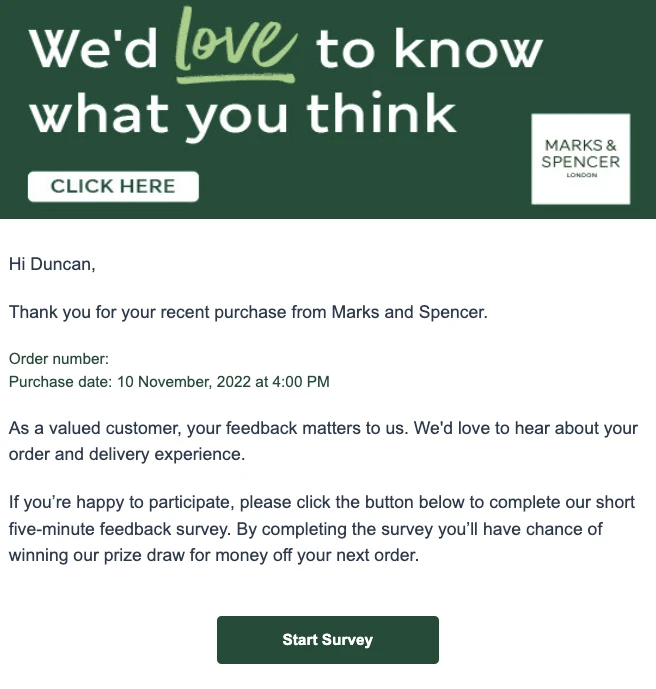
5. Review request email
Review request emails ask the buyer to review your product on your website or a third-party platform.
Like with survey emails, you should send product review request emails when the customer has had a chance to try your product without leaving it so long that they’re no longer excited. You can also send a follow-up reminder email.
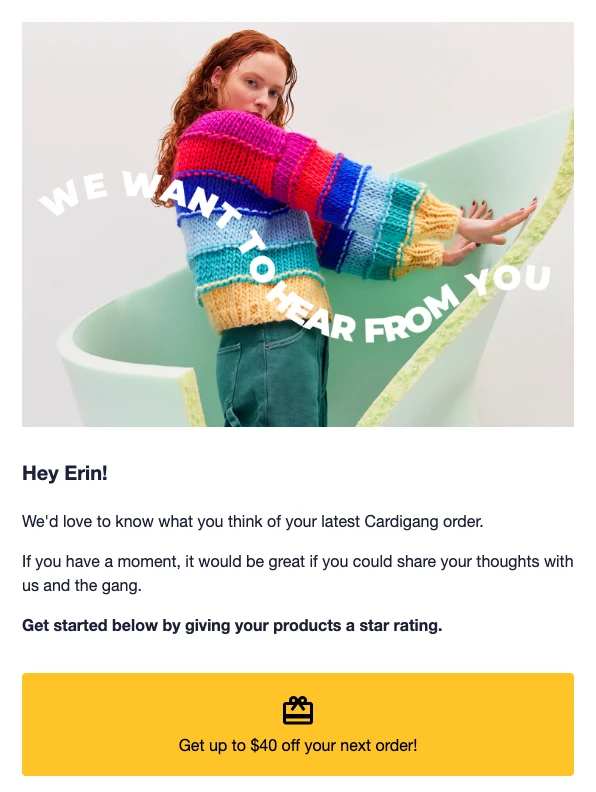
Optimize your review request email by keeping it simple, like in the Cardigang email above.
Consider including a:
Thank you note
Request for a review
Incentive for doing so, but be aware that some third-party sites don't allow incentivized reviews
Note about how the review will help
Link to the review platform
This keeps the focus of the email on leaving a review and means the recipient won’t get distracted by other types of content.
How to guarantee positive reviews?
Consider only sending review emails to people who answered your survey email positively. You can set this up by adding the subscriber's survey response as a field in their profile and then using the positive score to trigger a review email.
6. Product recommendations
Product recommendation emails increase repeat sales and boost customer lifetime value by promoting your products to existing customers.
Use knowledge of the product the person bought to make super-specific recommendations about what they may like to buy in the future.
Here are 3 post-purchase email marketing strategies:
Cross-selling
Promote products that are directly related to the product the customer bought. If someone bought shoes, promote shoe polish. Send cross-sell emails soon after the initial purchase.
Upselling
Promote a more expensive version of the product the customer bought. Upselling typically happens during the checkout process to increase order value, but it can work for some product types in post-sales emails.
For example, if you sell a product that results in repeat buys, like supplements, you could upsell the customer to a more expensive version or a larger package for the repeat purchase.
Send the email when the customer is likely to think about rebuying your product.
Emergency medical kit brand Live The Creed is an excellent example of how you can turn one-time buyers into loyal customers through strategic upsells via emails. The brand’s founder, Jonathan Barbera, says that most of his customers start by buying a low-cost medical kit.
Once they're impressed by the product, Jonathan sends them automated follow-up emails after 2 weeks through MailerLite’s purchases specific product trigger.
These emails focus on higher-value items that go perfectly hand-in-hand with their initial purchase.
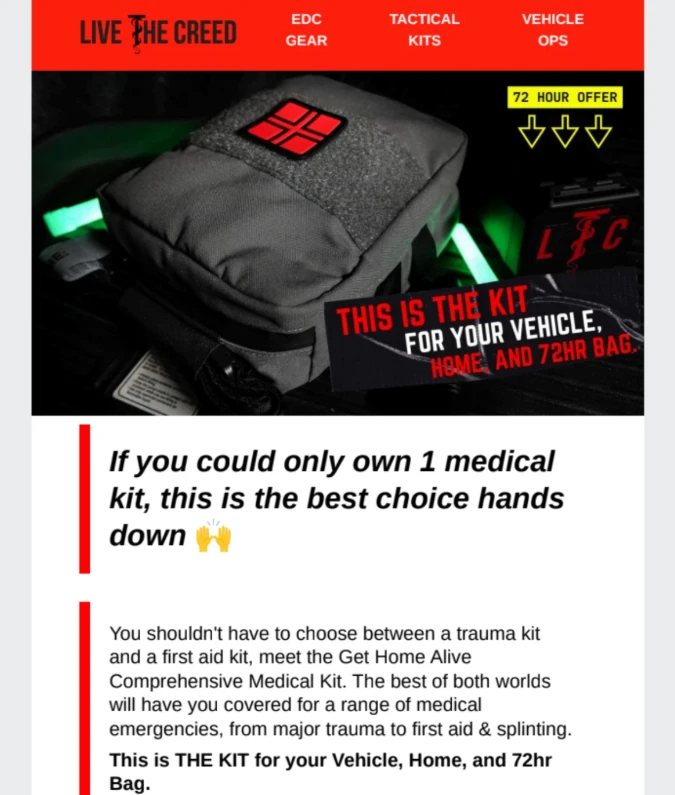
This simple automation has led to consistent repeat sales for the brand.
Related products
Promote products that you think the buyer may be interested in. For example, German tool distributor, KC Tool builds repeat sales with a targeted email for people who add a brand catalog to their shopping cart. Since a catalog download is a clear signal of future purchase interest, the company sends an automated follow-up email about a month later, asking if they've found anything they'd like to try. Founder Collin Thomas said:
We sent an automated email around a month later asking if they saw anything they like to try to pull them back in. And it just runs without us thinking about it.
As well as dedicated product emails, add product promotions to the other emails in your post-purchase sequence.
Cult Beauty recommends related products at the end of its shipping confirmation email. Adding the recommendations at the end ensures they don’t distract from the email’s main message.
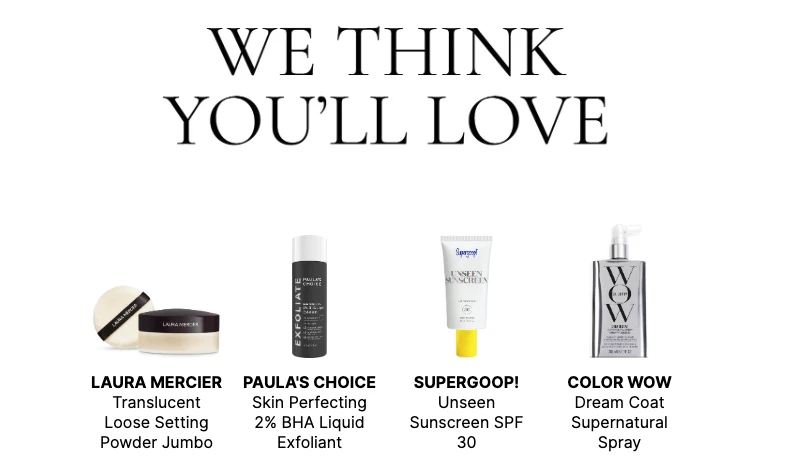
7. Loyalty program emails
Loyalty program emails are sent to encourage repeat sales by inviting customers to join your program.
Offer an incentive like a coupon, points, or a discount on their next purchase to increase the chances that people will sign up and eventually become loyal customers.
The below email from Squatch is a good example because it highlights that customers already have points waiting for them.
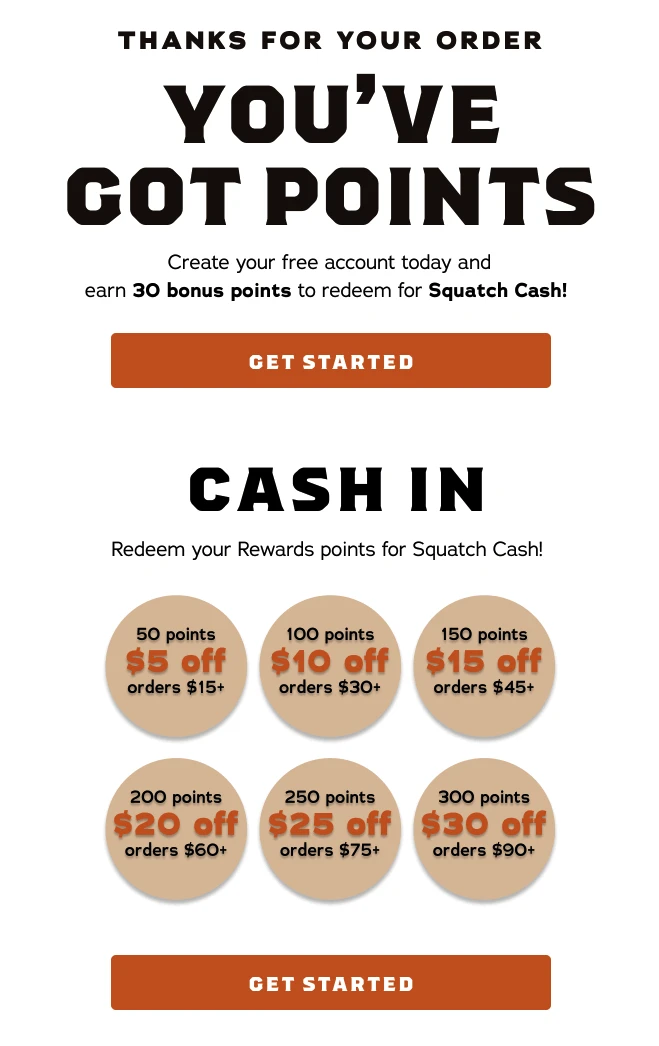
8. Referral program emails
Invite buyers to spread the word about your brand with a referral program email. These emails encourage referrals by offering a benefit, usually a discount, to both the person making and receiving the referral.
What to include:
Explain how it works
Highlight the benefits
Link to the rewards program signup
This email from The Body Shop is a great example. It includes all the above points, making the referral process extremely clear.
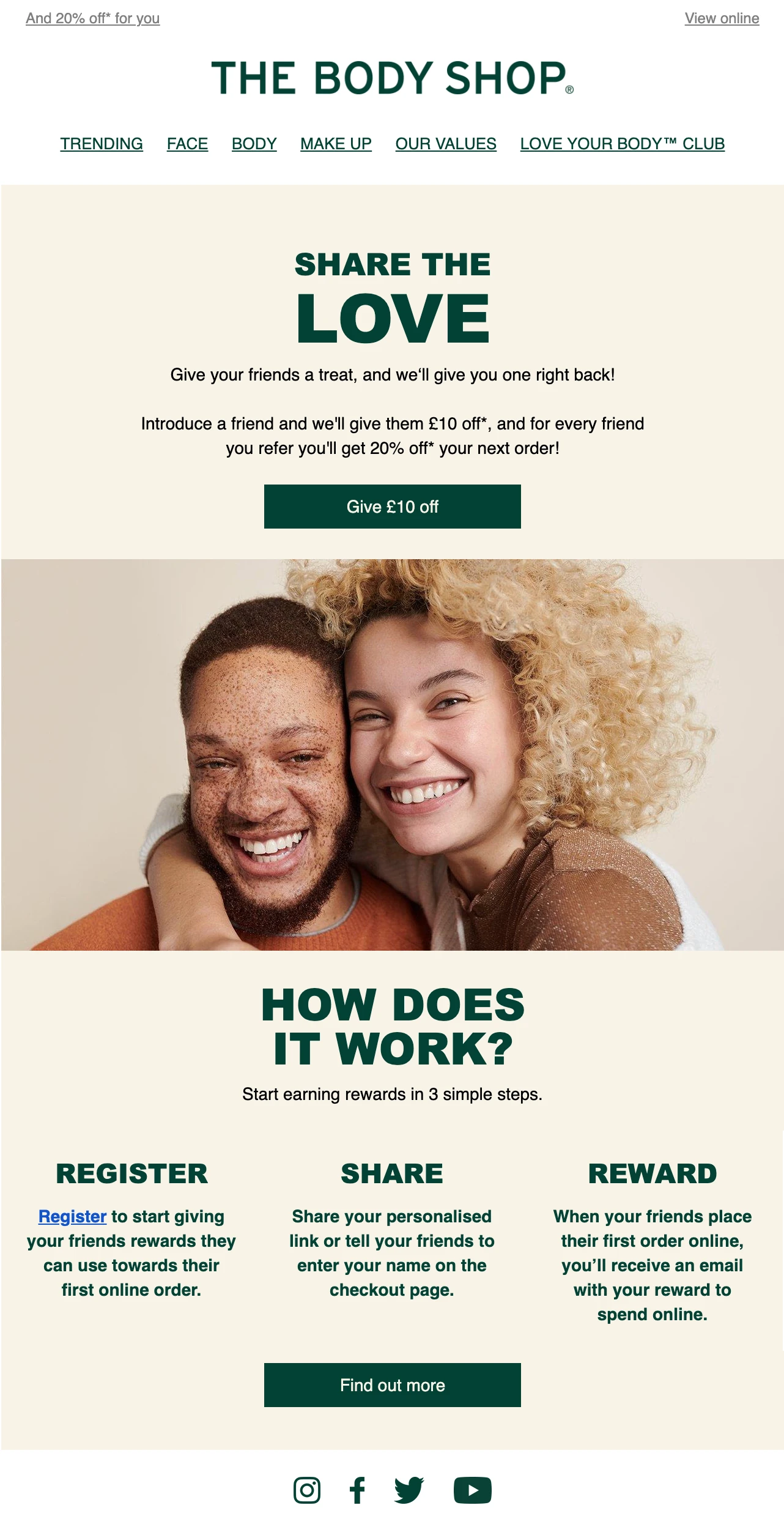
9. Re-order emails
Some products may benefit from re-order emails that remind buyers to buy again. Send these emails around the time the buyer will be considering another purchase.
This email from Moonpig is a good example of a re-order email. It uses the anniversary of the date the recipient bought a birthday card to remind them to buy another.
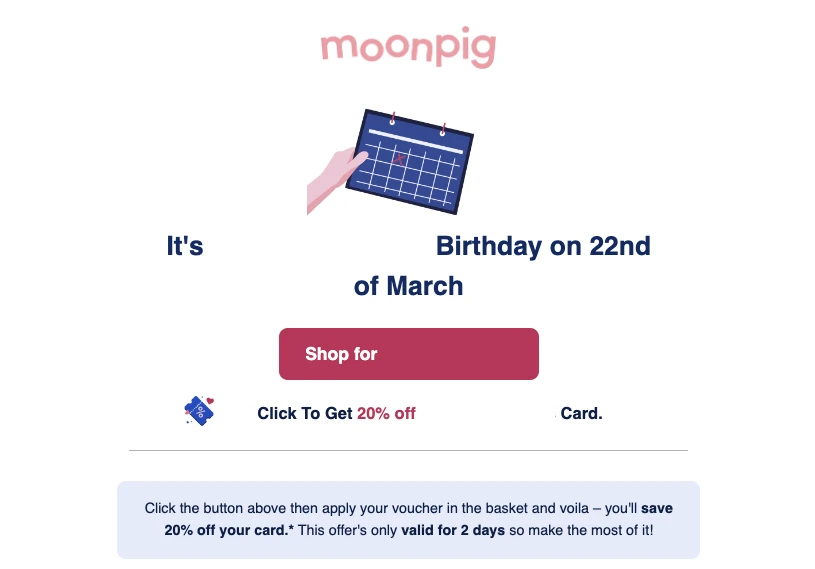
How to create a post-purchase email flow
Creating a post-purchase email flow is super easy with MailerLite. Just connect your e-commerce store using the relevant integration, and then build e-commerce automation with one of our post-purchase triggers.
The email, or email sequence, will go out automatically whenever someone buys a relevant product.
You can choose from three post-purchase triggers:
Buys a specific product: Trigger the email when someone buys the exact product specified. They’re perfect if you have just a few products that each require their own automation.
Buys a product category: Trigger the email when someone buys a product in a particular category. They allow you to tailor the automation to the product the person bought, without having to create a separate automation for each one
Buys any product: Trigger the email whenever someone buys a product from your store. They’re perfect for sharing general information or for emails like surveys that are relevant to any buyer.
When creating your automation, either add all your post-purchase emails to a single flow or create multiple flows for each use case.
For example, you could create a post-purchase flow with follow-up emails containing product information and a separate automation specifically for your survey and reviews.
Here are the setup steps in detail. They assume you have already connected MailerLite with your e-commerce store.
Head to the Automation section of your dashboard and click Create new automation
Click Start from scratch and name your automation
Set up your trigger by selecting e-commerce automation, choosing your store, and then choosing the trigger buys a specific product, any product, or from a category
Add a Delay block and choose the amount of time you want to pass between the trigger and the recipient receiving the email
Add your first email to the automation and design the email
At this point, you can either set your automation live by switching the toggle or add more emails. Just be sure to add a delay between each message to spread them out.
Check out this article on post purchase automation to learn in detail how to create post-purchase campaigns.
Don’t forget these post-purchase email campaign best practices
To maximize the impact of your post-purchase email strategy, focus on these core principles:
Strategic timing: Send the right message at the right moment
Clear goals: Keep each email focused on a single purpose
Compelling subject lines: Encourage opens and engagement
A/B testing: Continuously optimize for better results
Targeted personalization: Deliver relevant content to each customer
As our Email Marketing Specialist, Dorota Płachta, explains,
The first purchase is only the start of the customer journey and a key moment to drive retention. Treat post-purchase emails like any other emails—use A/B testing in your automations to optimize subject lines, content, and CTAs. Identify which elements resonate most with your customers and drive more repeat sales.
Let’s understand the best practices in detail:
Send emails at the right time
For some types of emails, like shipping or order confirmations, the right timing is essential. For others, like product recommendations or loyalty programs, you have a larger time window.
We’ve provided estimated timings for each of the email types in the relevant section. Also consider the specifics of your product, audience, and the other emails you send.
Once you’ve decided on an appropriate sending time, use automations to ensure your messages always go out when you want them to.
Focus on a single goal for each email
For maximum results, create a separate email for each goal and optimize the content and call-to-action around this target.
This focuses the customer on the specific task, increasing the chances that they perform and don’t get distracted by other content.
For example, if you want to invite people to your loyalty program and ask them for a review, create two separate emails to do so.
If you’re worried about this taking up a lot of time, create a reusable email template. You can then simply change the content for each type of email.
Write a subject line that stands out
As with any form of email marketing, a good subject line is key to getting people to open your messages.
Transactional messages like order confirmations typically have very high open rates, so you just need to clearly explain what the message contains.
For more promotional messages, consider highlighting the benefits of the email to encourage people to open it.
You can also experiment with emojis, personalization and highlighting different offers.
Order confirmation
Success! Your Order is Confirmed
Thanks For Your Order With [Store Name]
Order Confirmation & Next Steps
Shipping confirmation
Good News: Your Package Is On Its Way
Update: Your Order is En Route
Your Order Has Been Shipped
Follow-up emails
Keep It Like New: Care Tips for Your Recent Purchase
Getting the Best Out of Your New Purchase
3 Steps To Set Up Your New Product
Survey emails
Your Opinion Matters: Help Shape Our Future
Help Us Make [Product Name] Even Better
Love Your Recent Purchase? Tell Us All About It!
Review request emails
Help Others by Sharing Your Experience
Got a Minute? Leave a Review for Your Recent Purchase
We Would Like Your Opinion
Product recommendations
You Might Also Love: Handpicked Selections Just for You
Recommended: [product name]
New Products You Shouldn't Miss
Loyalty program invite
You're Invited: Join Our Loyalty Program For Exclusive Benefits!
Unlock Exclusive Perks: Become a Loyalty Member Today
A Special Invitation To Our VIP Circle
Referral program
Invite Friends, Get Rewards: Join Our Referral Program!
You're Invited: Share the Love & Earn Exclusive Rewards
Your Next Reward is Just a Referral Away!
Re-order emails
Time for a Refill? Re-order Now & Never Run Out
[relevant date/event] is coming up. Re-order now!
Enjoy a Special Discount on Your Next Re-order!
A/B test your emails
Optimize your post-purchase emails by A/B testing your automations to see what works. For example, you could test 2 versions of:
An email subject line to see which gets the most opens
Referral program invite email content to see which results in the most clicks
You can then roll the version with the best metrics to all future purchases, maximizing the impact of your messages.
Target your emails
We touched on this in the above section, but it’s important to target your e-commerce emails at different buyers.
One way to do this is by creating different flows for products or product types. Or you can add content to emails that show up dynamically to people in different audience groups.
MailerLite’s Customer Education Specialist, Harmony Riveros, says:
If you want to send the same post-purchase flow to several different types of customers, you can use multiple triggers! This means one workflow could be triggered when a subscriber buys any 2-3 specific products instead of just one. Reach more customers and simplify the backend.
You can also use email personalization to add customer data, such as their name, to your email content and subject lines.
Final Thoughts: Time to start building your email flow
Now you know more about post-purchase emails, the next step is to start building. Choose some of the post-purchase email ideas above, then head over to your MailerLite dashboard to start. If you don’t have an account yet, hit the button below to create one for free.
Create post-purchase emails that customers love
Sign up for MailerLite to optimize your post-purchase experience with email automation. Get a free 14-day free trial of premium features to connect your store and start building.
